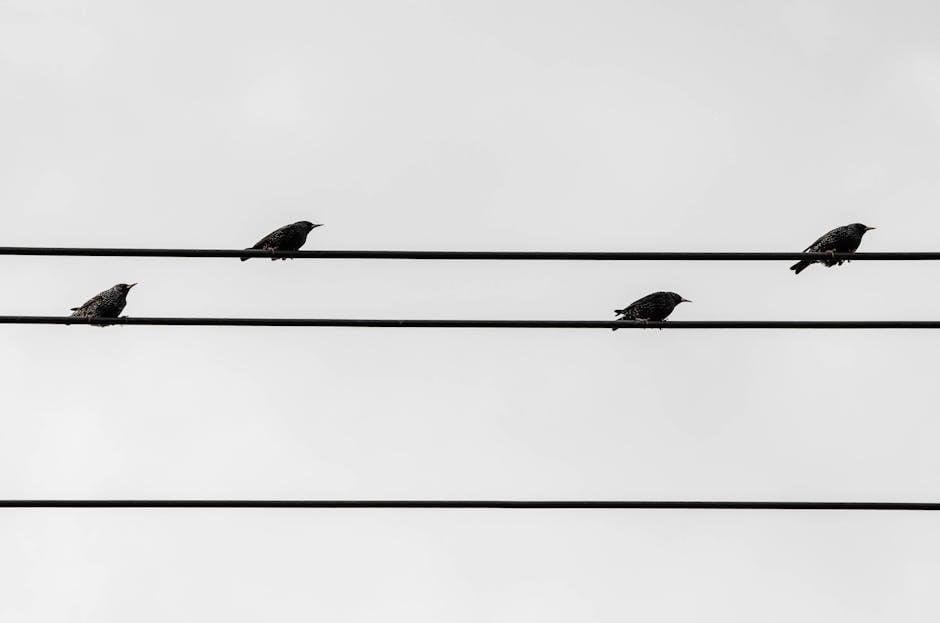Choosing the right fishing line is essential for a successful angling experience. This guide explores various types of lines, factors influencing selection, and expert recommendations to enhance your fishing prowess.

Understanding Fishing Line Types
Fishing lines come in three primary types: monofilament, fluorocarbon, and braided. Each offers unique properties, such as strength, invisibility, and durability, tailored to specific fishing conditions and techniques.
Monofilament Line
Monofilament line is the most versatile and user-friendly option for anglers. Made from a single strand of nylon, it offers excellent strength, knot resistance, and buoyancy. Its medium diameter provides good visibility and durability, making it suitable for a wide range of fishing conditions. Monofilament lines are resistant to UV damage and abrasion, ensuring longevity. They are ideal for both freshwater and saltwater fishing, offering consistent performance. This line is particularly recommended for beginners due to its ease of use and cost-effectiveness. Its slight stretch allows for shock absorption, reducing the risk of line breakage during aggressive strikes. Monofilament remains a reliable choice for anglers targeting various species.
Fluorocarbon Line
Fluorocarbon line is a high-performance option favored by anglers for its exceptional clarity and sensitivity. Unlike monofilament, fluorocarbon is nearly invisible underwater, making it ideal for clear water conditions. It has a faster sink rate and higher abrasion resistance, which is beneficial for bottom fishing and resisting sharp objects. The molecular structure of fluorocarbon reduces stretch, enhancing sensitivity and hook-setting power. While it is more expensive and stiffer than monofilament, its durability and performance make it a preferred choice for anglers targeting species in challenging environments. Fluorocarbon lines are particularly effective in scenarios where invisibility and strength are crucial, such as in fly fishing or with braided lines.
Braided Line
Braided line, made from polyethylene fibers, offers exceptional strength, durability, and sensitivity. Its low stretch allows for precise control and instant hook sets, making it ideal for techniques like jigging or trolling. Braided lines are thin in diameter, enabling long casts and deep presentations. However, their visibility and harshness on guides can be drawbacks. To mitigate this, anglers often pair braided lines with a fluorocarbon leader. Braided lines are versatile, suitable for both fresh and saltwater fishing, and excel in heavy cover or when targeting large, powerful species. Their high knot strength and resistance to abrasion make them a favorite for demanding fishing conditions and applications requiring maximum reliability.

Factors in Choosing the Right Fishing Line
Selecting the ideal fishing line depends on the target species, water conditions, and fishing technique. Consider factors like strength, stretch, and abrasion resistance to ensure a successful angling experience.
Fish Species and Water Conditions
The choice of fishing line is heavily influenced by the target species and the environment. For smaller fish like trout or panfish, monofilament lines with lower pound tests are ideal due to their flexibility and knot strength. In clearer waters, fluorocarbon lines are preferred as they are nearly invisible, reducing the chances of spooking cautious fish; For larger species like bass or pike, braided lines offer superior strength and durability, especially in dense vegetation or rocky areas where abrasion resistance is crucial. Understanding these dynamics ensures the right line is selected for optimal performance and success in various fishing scenarios.
Fishing Techniques and Gear
Fishing techniques and gear significantly impact line selection. Spinning reels often pair well with monofilament or fluorocarbon lines due to their reduced line twist and better casting performance. Braided lines, with their thin diameter and low stretch, are ideal for baitcasting reels and techniques requiring sensitivity, like jigging or trolling. Fly fishing demands weighted lines that match the rod’s action, ensuring accurate casts and presentation. The choice of lures or bait also influences line type, as certain lines offer better abrasion resistance or responsiveness. Matching the line to the technique and gear ensures a seamless fishing experience and maximizes chances of success on the water.

Understanding Pound Test and Diameter
Pound test refers to a fishing line’s strength, indicating the maximum weight it can hold before breaking. Diameter measures the line’s thickness, influencing castability and visibility. Thinner lines, like braided options, offer superior strength-to-diameter ratios, enabling longer casts and less visibility in water. Heavier lines, while stronger, may sacrifice sensitivity and stealth. Balancing pound test and diameter is crucial for specific fishing scenarios, ensuring the line matches the target species and tackle. Proper selection enhances performance, preventing break-offs and improving hook sets. Understanding these metrics helps anglers choose the optimal line for their needs, ensuring a more successful and enjoyable fishing experience.

Importance of Leaders in Fishing
A leader connects the main line to the lure or bait, providing strength, abrasion resistance, and improving presentation. Essential for fly fishing and with braided lines, it protects the main line.
Leaders in Fly Fishing
In fly fishing, a leader is a crucial component, connecting the fly line to the fly. It is designed to transition the weight from the thicker fly line to the lighter tippet, ensuring a smooth presentation. Leaders are typically made from monofilament or fluorocarbon materials, chosen for their strength, flexibility, and near-invisibility underwater. The leader’s length and taper are selected based on fishing conditions and target species, with longer leaders often used in clear water to avoid spooking fish. Properly matching the leader to the fly line and tippet is essential for effective casting and presentation, making it a key element in fly fishing success.
Using Leaders with Braided Lines
When using braided lines, a leader is often essential to reduce line visibility and prevent fish from being spooked. Braided lines are highly visible and can create a stark contrast in clear water, making fish wary. A fluorocarbon or monofilament leader acts as a buffer, blending into the water and improving presentation. Leaders also protect the braided line from abrasion caused by rough underwater structures. The length of the leader varies depending on fishing conditions, with longer leaders used in clearer waters. Additionally, a leader helps prevent line twist when using lures or live bait, ensuring a smoother fishing experience overall.
Knots and Spooling Techniques
Mastering essential fishing knots and proper spooling techniques ensures secure connections, reduces tangles, and enhances overall fishing efficiency and effectiveness for anglers of all skill levels.
Essential Fishing Knots
Mastering essential fishing knots is crucial for securing hooks, lures, and leaders effectively. The clinch knot is a popular choice for attaching lures or hooks to monofilament or fluorocarbon lines. The Palomar knot is known for its strength and reliability, ideal for braided lines. The barrel knot simplifies joining two lines, while the loop knot preserves lure action. Properly tying these knots ensures minimal line breakage and hook slippage. Regular practice and using the right techniques will help anglers maintain confidence in their gear. Always check knots before casting and after catching fish to ensure reliability. A well-tied knot is the foundation of a successful fishing experience.
Proper Spooling Methods
Proper spooling is vital for optimal line performance and to prevent tangles or twists. When spooling a new line, ensure the reel is correctly aligned with the line’s direction. For braided lines, use a fluorocarbon or monofilament backing to prevent slippage. Fill the spool to the recommended level, leaving about 1/8 inch of space. Avoid overfilling, as this can lead to line overlap and tangling. Wet monofilament and fluorocarbon lines before winding to reduce memory. For braided lines, apply gentle tension while spooling to avoid twists. Regularly check the line for even distribution and adjust as needed. Proper spooling ensures smooth casting and durability, enhancing your fishing experience.
Seasonal Fishing Strategies
Adapt your fishing line setup and techniques based on the season. In winter, streamer techniques excel, while spring and fall call for nymphing and dry fly tactics. Adjust line weight and visibility to match seasonal fish behavior and water conditions for optimal results.
Winter and Streamer Techniques
In winter, streamer techniques are highly effective as they allow anglers to cover vast water areas, presenting flies directly to fish. Using a fluorocarbon or monofilament line with a clear or low-visibility color is recommended to avoid spooking fish in clear, cold water. Heavier lines may be necessary to handle larger streamers and strong currents. The use of a fluorocarbon leader can enhance presentation and sensitivity. Swinging streamers near structure or in deeper pools is a proven strategy, as fish tend to hold in these areas during colder months. Adjusting line weight and retrieval speed can also improve success rates in these conditions.
Spring and Fall Tactics
In spring and fall, trout and other species are often more active, making these seasons ideal for specific tactics. During spring, focus on topwater lures and lighter lines to mimic baitfish or insects. Fluorocarbon lines are excellent for clear water, as they reduce visibility and increase strike chances. In fall, as trout become more aggressive, switch to slightly heavier lines and streamers that imitate baitfish or crayfish. Varying retrieval speeds and depths can trigger strikes. Using a monofilament or braided line with a fluorocarbon leader enhances sensitivity and durability, ensuring better control during these dynamic fishing conditions. Adjusting line weight and presentation is key to success in these transitional seasons.
Line Maintenance and Care
Proper maintenance ensures your fishing line lasts longer and performs optimally. Regularly clean your line with mild soap and water to remove dirt and oils. Inspect for abrasions, knots, or UV damage, as these weaken the line. Replace damaged sections promptly to avoid breakage during fishing. Store your line in a cool, dry place, away from direct sunlight, to prevent degradation. For braided lines, avoid harsh chemicals, as they can weaken the fibers. Fluorocarbon lines benefit from occasional conditioning to maintain flexibility. Regular care extends the life of your line, ensuring reliability and performance on the water.
Top Picks and Recommendations
Based on performance and popularity, top picks include Berkley Trilene Big Game for monofilament, Seaguar Red Label for fluorocarbon, and PowerPro Spectra Fiber for braided lines. These options offer exceptional strength, sensitivity, and durability. For all-purpose fishing, Ande Monofilament and Sufix 832 Ice are highly rated. When choosing, consider your target species, water conditions, and technique. These lines balance quality and value, ensuring reliability and success on the water. Whether you’re a novice or experienced angler, these recommendations provide optimal performance for various fishing scenarios.